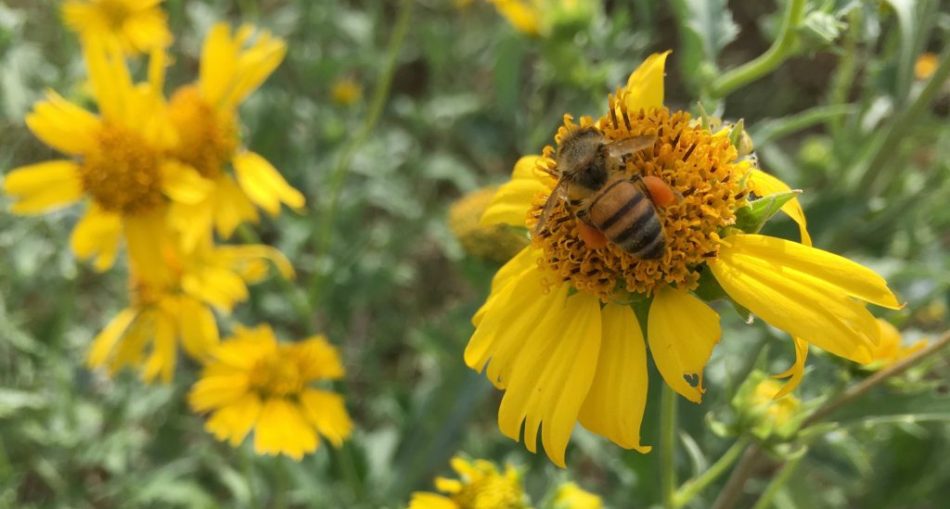While walking you may have noticed tiny daisies emerging from the long grass along the roadside or inside an abandoned yard. If you’re anything like me you might have even picked some of these daisies on your stroll. These wild daisies usually come in two colours: yellow and white. They’re beautiful, decorative flowers that add a lively touch to your otherwise mundane walk. Let us take a look at three common daisies you may have seen.
1. Ox-Eye Daisy
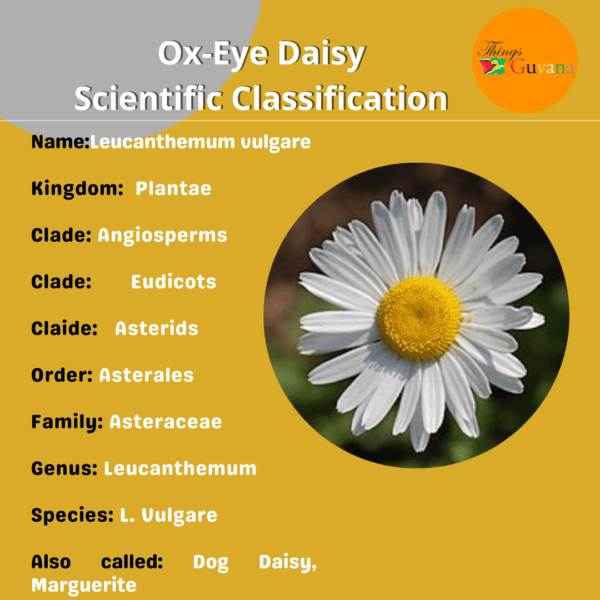
Description
Ox-Eye daisy is a herb that grows to 80 centimeters and has a creeping underground root system. The lower parts of the stem are hairy, sometimes densely hairy. The largest leaves are at the base of the plant and are 4–15 cm and have a petiole. These leaves have up to 15 lobes. The leaves decrease in size up the stem, the upper leaves up to 7.5 cm long, and lack a petiole. The plant can bear up to three flowers like any other daisy. Each of the flowers has at least 15 petals to forty white petals.
Fun Fact: The ox-eye daisy was first mentioned in 1778 by Jean- Baptiste Lamarck.
Habitat
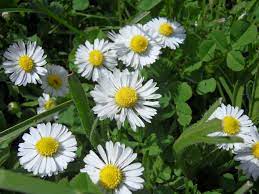
Photo showing the ox-eye daisy growing in grasslands. Photo Source: https://pxhere.com/en/photo/60619
The ox-eye daisy is a widespread flowering plant native to Europe and the temperate regions of Asia. It is usually seen growing by roadsides or any abandoned yard spaces. It is considered an invasive species because it reduces the amount of food for livestock.
Uses
There is no scientific evidence to show that the ow eye daisy can be used as medicine but it has been used to treat respiratory illnesses such as the common cold, cough, bronchitis, fever, sore mouth and throat, complaints of the liver and gallbladder, loss of appetite, muscle spasms, fluid retention, and propensity to infection are all treated with ox-eye daisy. A tonic is another use for it. Some people apply ox-eye daisy directly to the skin for pain and swelling (inflammation), wounds, and burns.
The buds can be marinated in order to be eaten.
It can be used for landscaping
2. Yellow Crownbeard
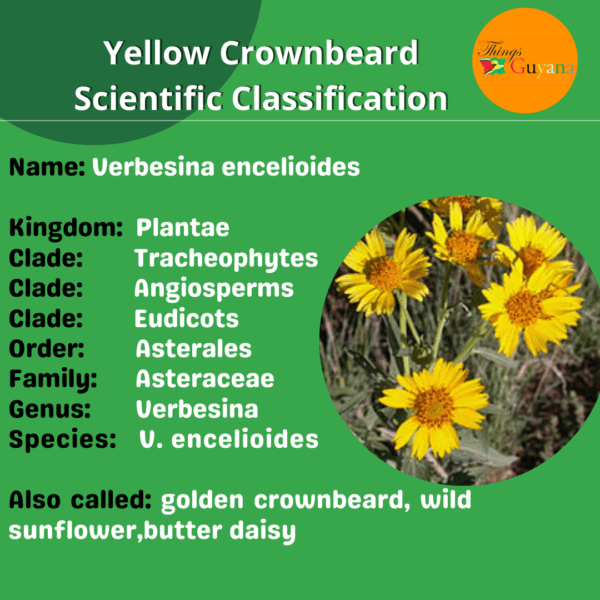
Description
Also known as Golden Crownbeard, the Cowpen daisy is an annual plant that loves sandy and disturbed soils. It has many branches covered with large yellow blooms. It can grow up to 1-3 ft tall and likes to grow in disturbed sites. The leaves often have serrated margins and are triangular in form. The very thin white hairs that cover them give them their gray-green look. They will be opposite of each other on the lower part of the plant before becoming alternatives to each other higher up.
Fun Fact: Cowpen Daisy is too wonderful to pass up for long-tongued bees like bumblebees, honey bees, big leaf-cutting bees, small carpenter bees, and cuckoo bees since they are a good supply of nectar.
Habitat
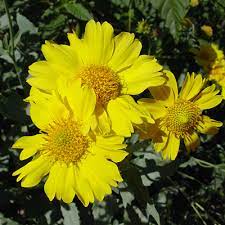
Photo of Yellow Crownbeard. Photo Source: https://www.fireflyforest.com/flowers/2522/verbesina-encelioides-golden-crownbeard/
These plants are found in disturbed areas throughout Texas, especially in the drier parts. Sand, loam, clay, limestone. The species is native to many parts of the United States and Mexico. It is naturalized in other parts of North America, the Middle East, Spain, Argentina, Australia, and the Pacific islands.
Uses
The Yellow crownbeard has been used for medicinal purposes. It contains azulene blue which is known for its anti-inflammatory properties. Additionally, it has been used as a tea to soothe the pain of arthritis, and lower fevers, promote perspiration and lessen gum and mouth irritation. It has been applied topically to treat inflammation such as hemorrhoids, postpartum inflammation, and skin ulcers with compresses, soaks, and salves.
Black-Jack Plant
This plant is one that you would commonly grow near the roadside in Guyana. It is personally a favourite of mine to pick.
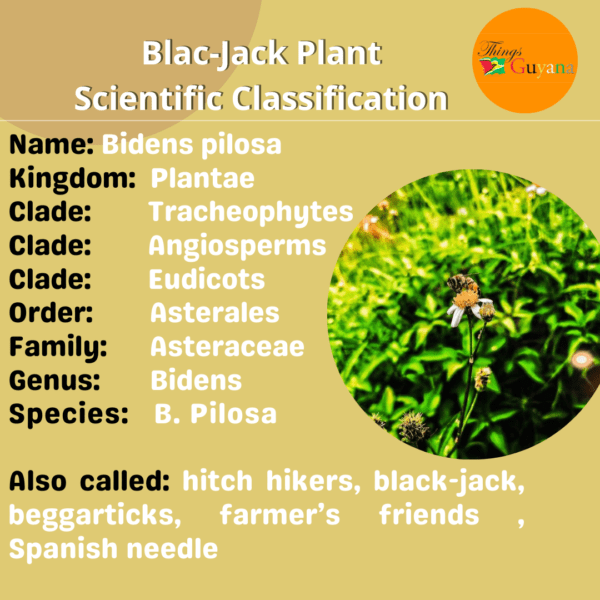
Description
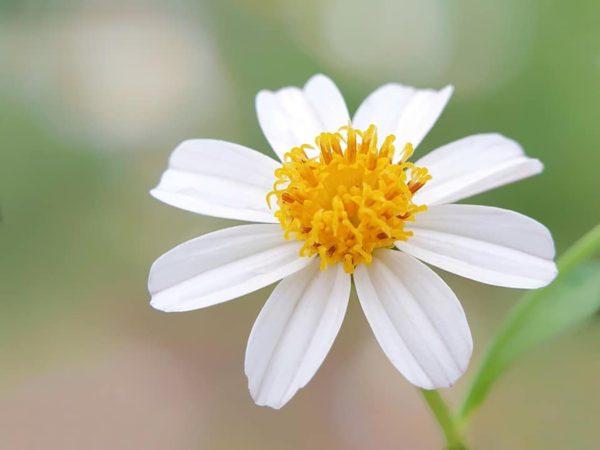
Photo of Black-Jack. Photo Source: https://pixabay.com/photos/black-jack-flower-flower-plant-6605703/
An annual herb, Bidens pilosa grows to a height of 1.5 m with an upright habit. The elongated fruits that have hooked bristles (burrs) that cling to people’s clothing as they brush past the stems make it simple to identify.
The majority of stems are hairless, square in cross-section, and green to purplish in colour. The petioles, or leaf stalks, of the oppositely oriented leaves, measure 1 to 6.5 cm in length. Their margins feature serrated teeth. The shapes of leaf blades vary. Simple and roughly oval-shaped leaves are more common near the plant’s base than compound (pinnate) leaves with three to seven egg-shaped (ovate) leaflets further up the plant. Smaller, simpler, or more oblong-shaped leaves are found at the plant’s top. Sizes for leaves or leaflets range from 1.5-7 x 0.5-3.5 cm.
Flower heads have yellow center (tubular) florets and are 7-8 mm in diameter. Some plants produce flowerheads with up to 1.5 cm long white or cream “petals” (ray florets), but these “petals” may not be present or may be very small. At the terminals of the branches, heads are grouped in branched inflorescences. The majority of the year is spent flowering. The seeds have a row of two to four barbed awns (2-4 mm long) at one end and are black, flattened, and linear in shape (0.4-1.6 cm long).
Habitat
Black-Jack or Bidens Pilosa can invade roadsides, crops, pastures, gardens, disturbed areas, fallow lands, and urban open space.
Fun Fact: B. pilosa was first collected and named by Carl Linnaeus in 1753.
Uses
Nutritional Contents:
Vitamin C – contains 63 milligrams. An adult needs 73 to 90 mg daily. Vitamin C acts as an antioxidant and also helps your body make collagen, which helps your body heal wounds.
Iron – Blackjack plant is also a good source of iron (15 milligrams per 100 grams), and zinc (19 milligrams per 100 grams). Iron is a mineral that the body needs for growth and development. Your body uses iron to make hemoglobin, a protein in red blood cells that carries oxygen from the lungs to all parts of the body.
Benefits
- The root, leaves, and seeds of the Spanish Needle have been known to possess anti-inflammatory, antibacterial, antiseptic, antimicrobial, and antidysenteric properties. Spanish Needle also serves as a diuretic and contains antimalarial properties, making extracts from the plant treatment for malaria in certain cultures.
- Due to the plant’s antiseptic properties, plant extract may also be used as a natural mouthwash to combat odour-causing germs along with sore gums and mouth.
- The herb is also beneficial in treating joint discomfort, swelling, colic, and stomach ailments along with the cold and flu.
To learn more about the medicinal properties of Black- jack plant click here – https://www.thingsguyana.com/medical-benefits-of-the-black-jack-plant-includes-recipe/
References:
Ox-Eye Daisy :
- https://en.wikipedia.org/wiki/Leucanthemum_vulgare
- https://www.webmd.com/vitamins/ai/ingredientmono-60/ox-eye-daisy#:~:text=Ox%2Deye%20daisy%20
Yellow Crownbeard:
- https://en.wikipedia.org/wiki/Verbesina_encelioides
- https://npsot.org/wp/story/2012/3082/
- https://www.taosnews.com/la-vida/herb-of-the-month-golden-crownbeard-goldweed/article_7d11db83-a78f-563b-a27f-40f0a6a9c94f.html#:~:text=It%20has%20also%20been%20used,postpartum%20inflammation%20and%20skin%20ulcers.
Black-Jack:
- https://keys.lucidcentral.org/keys/v3/eafrinet/weeds/key/weeds/Media/Html/Bidens_pilosa_(Blackjack).htm
- https://www.tibb.co.za/wp-content/uploads/2022/03/health-benefits-of-black-jack.pdf
- https://www.webmd.com/a-to-z-guides/what-to-know-about-blackjack-bidens-pilosa
Discover more from Things Guyana
Subscribe to get the latest posts sent to your email.

